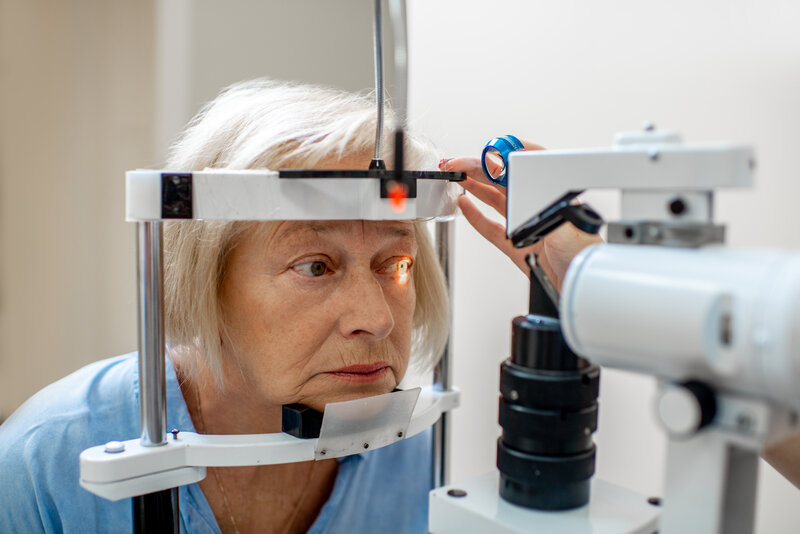Posted by: Atlantic Eye Institute in Education

Glaucoma’s lack of signs and symptoms makes it one of the scariest forms of vision loss. Observing regular eye exams is the only way to catch this leading cause of vision loss before it does further damage. While glaucoma can be managed, the damage can’t be reversed, which makes early detection and treating glaucoma essential.
The most important takeaway is that attending annual eye exams is the best way to detect glaucoma early and while it can still be treated.
Symptoms Of Glaucoma
Glaucoma is an umbrella term that describes damage to the optic nerve caused by various conditions – all of which cause high-pressure levels inside the eye that put chronic pressure on the optic nerve. It is one of the most common types of vision loss. While glaucoma is more common in patients 65 or older, young people can still develop serious eye conditions.
Most of the time, people with glaucoma have no idea because it doesn’t typically present with any symptoms. Instead, the effects on the optic nerve occur over time and so gradually that by the time symptoms occur, some level of permanent vision loss is apparent.
If glaucoma goes undetected for too long, patients experience:
- Noticeable vision loss, typically in the form of patchy blind spots in the periphery (sides) of your vision.
- Eventually, blind spots occur in the central vision.
As mentioned, there are different types of glaucoma so symptoms vary accordingly.
Open-Angle Glaucoma
This is the most common type of glaucoma. If glaucoma goes undetected for too long, patients experience:
- Noticeable vision loss, typically in the form of patchy blind spots in the periphery (sides) of your vision.
- Eventually, blind spots occur in the central vision.
Normal-Tension Glaucoma
Like open-angle glaucoma, you won’t know you have it during the early stages. As it progresses, patients complain of:
- Vision that becomes gradually more blurry
- Eventual and complete loss of side vision (peripheral)
Closed (Or Acute) Angle Glaucoma
This is the most serious type of glaucoma and is considered a medical emergency. Patients with closed-angle glaucoma experience symptoms earlier than with other types of glaucoma. These include:
- Intense eye pain
- Headaches
- Nausea that may cause vomiting
- Colored rings or halos around lights
- Eye redness
- Blurry vision
Pigmentary Glaucoma
Once pigmentary glaucoma progresses to the symptomatic stages, patients experience:
- Colored halos or circles around lights
- Vision that blurs during exercise or activities that accelerate heart rate
- A gradual loss of peripheral vision
Childhood Glaucoma
Most cases of glaucoma are age-related in nature, for the most part. However, childhood glaucoma does exist. Symptoms show up sooner in children with glaucoma, typically as infants or toddlers. Parents or a pediatrician’s exam may detect:
- Cloudy or dull eyes
- Eyes that tear even when a child isn’t crying
- More than normal blinking
- Nearsightedness that grows notably worse in a short amount of time
- Blurry vision
- Halos around lights
While glaucoma-related vision loss can’t be reversed, we can treat it and do our best to keep it from getting worse. Making healthy lifestyle choices also support preventing and treating glaucoma since things like diabetes and high blood pressure increase glaucoma risk.
Diagnosing Glaucoma
There are several tests used to diagnose glaucoma, all of which are performed during routine eye exams. These tests include:
Eye pressure check
Optometrists perform the eye pressure check using a tonometry machine that blows a blast of air against the eye’s surface to measure the pressure.
Angle exam
The eyes’ drainage system is located at the angle where the cornea meets the lens. During the angle exam, we use the numbing drops and then place a special lens on the eye’s surface to examine that angle. You may have glaucoma if it’s closed or the drainage seems blocked.
Corneal thickness measurements
The thinner the cornea, the higher your risk of glaucoma. After numbing your eye, we’ll gently press on the cornea using a special probe to test its thickness.
Dilated eye exam (optic nerve exam)
Instead of numbing your eye, we’ll put drops that dilate your pupils. Once the pupils are fully dilated, we seat you in front of a machine that allows us to examine – and get images of – the retina, optic, nerve, and surrounding blood vessels where we’ll see signs of damage.
Dilation drops cause intense light sensitivity, so you’ll need a pair of dark, UV-proof sunglasses when you leave our office. If you don’t have any, we’ll provide them for you. Your vision will also be affected until the dilating drops wear off.
Visual field test
We also test your visual field since the loss of peripheral (side) vision is a common symptom of undiagnosed glaucoma.
Treating Glaucoma
Glaucoma tests provide real-time information so your optometrist knows right away if you have glaucoma and will discuss treatment options with you. In most cases, they’ll refer you to an ophthalmologist, a medical doctor specializing in diagnosing, managing, and treating more serious eye conditions.
Treating glaucoma includes:
- More regular eye checks.
- Prescription medications (drops or pills) that help relieve pressure inside the eye.
- Surgery – depending on the patient, we may recommend surgical options that help drain excess eye fluid to reduce overall pressure on the optic nerve.
- Laser treatment that increases eye fluid drainage.
Don’t Let Symptoms Of Glaucoma Sneak Up On You
Are you overdue for an eye exam? Have you been putting off eye exams because you can see “just fine?” Don’t take the risk of unknowingly letting symptoms of glaucoma sneak up on you. By the time they do, vision loss may be a permanent consequence. Schedule an eye exam with Atlantic Eye Institute so we can take proactive care of your eyes and vision health.



